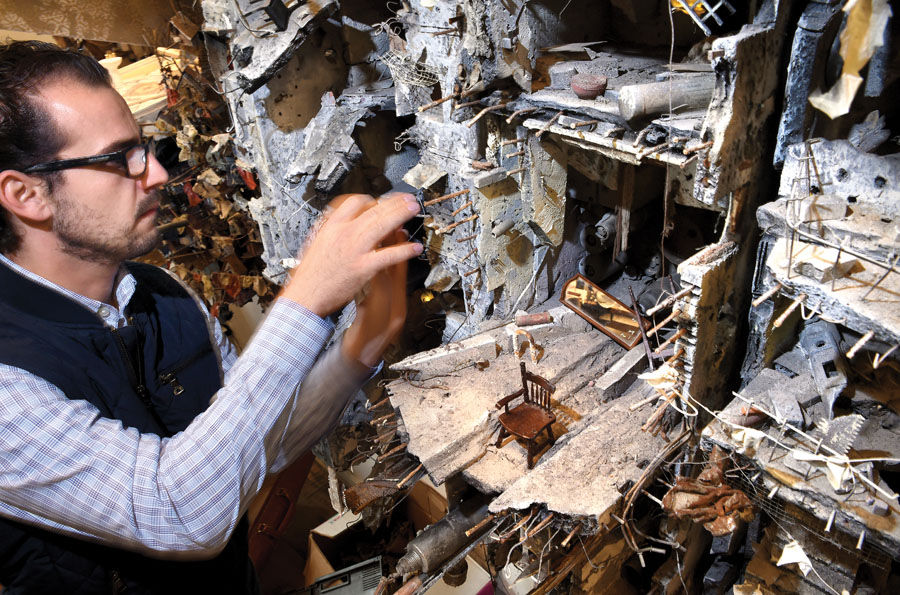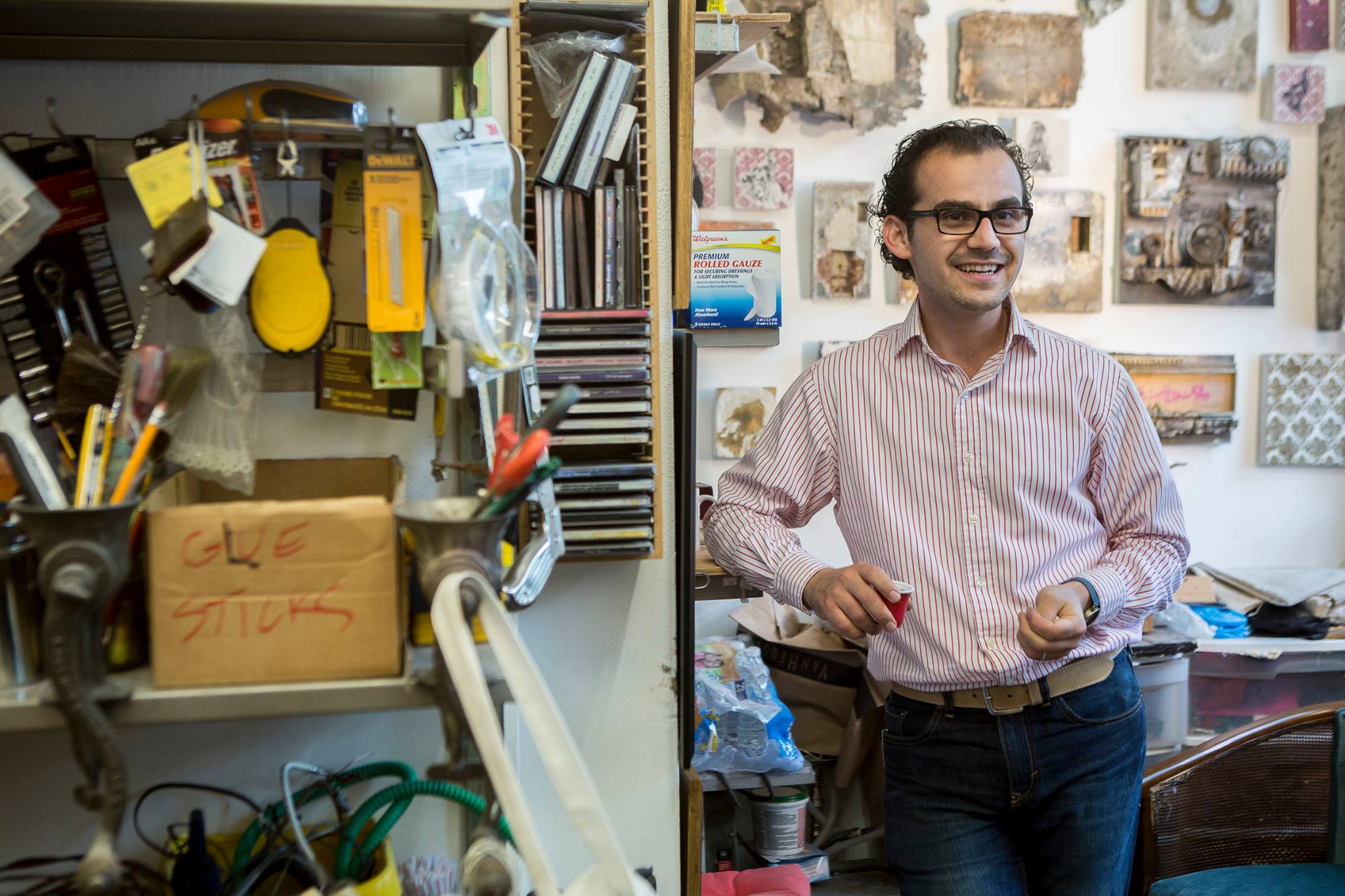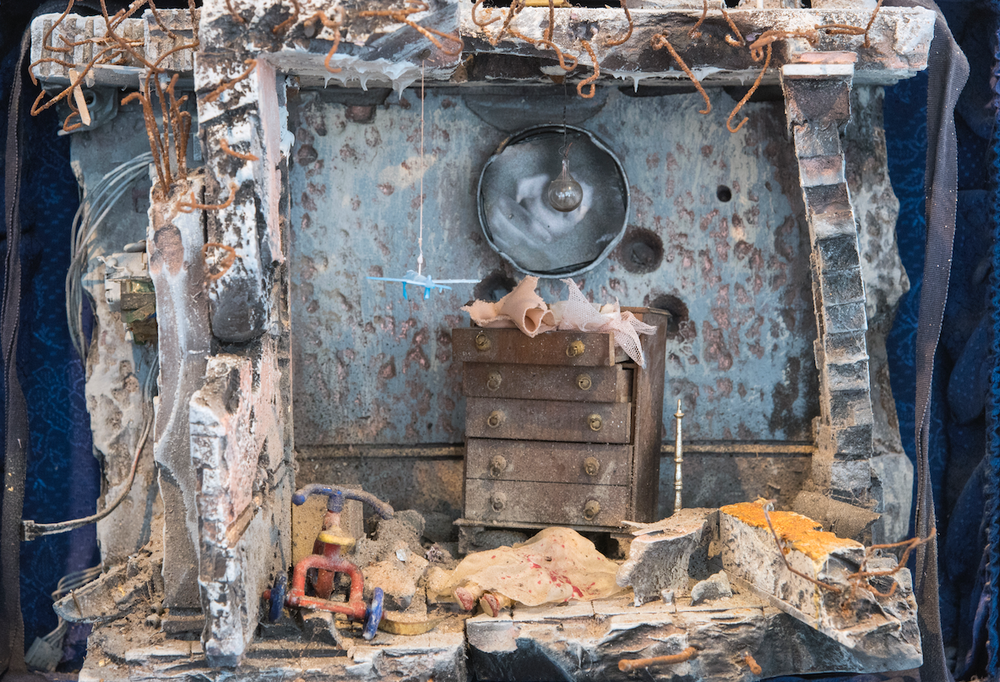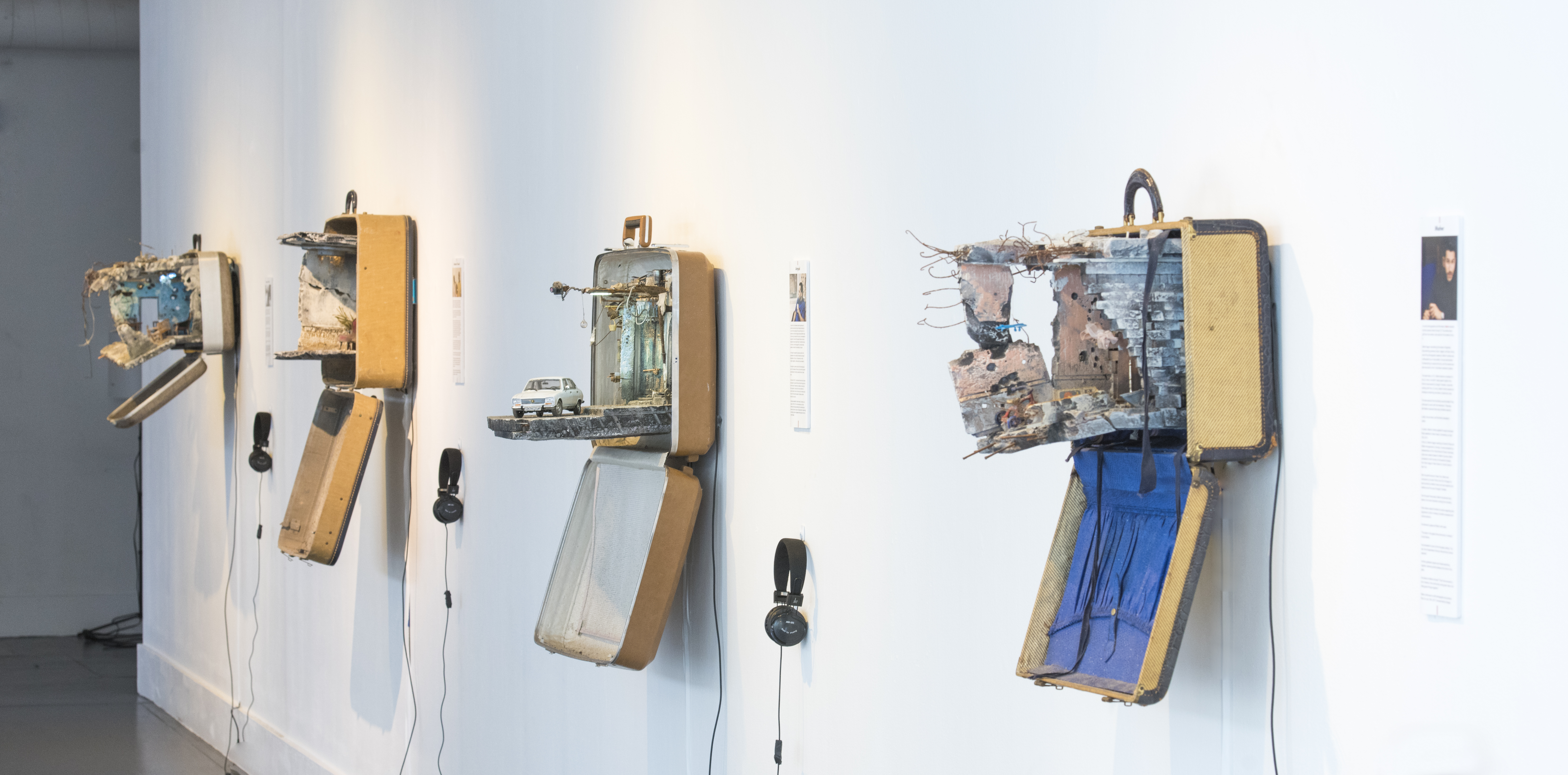Miniature Scenes Tell Refugees’ Stories in UNPACKED: Refugee Baggage by Mohamad Hafez and Ahmed Badr
| Mohamad Hafez Art | UNPACKED: Refugee Baggage |
| Mohamad Hafez Facebook | UNPACKED Facebook |
| Mohamad Hafez Instagram | UNPACKED Instagram |
| Mohamad Hafez Twitter | UNPACKED Twitter |
| as featured in The New Yorker | as featured in The New York Times |
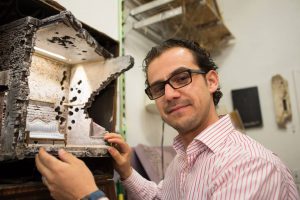 What’s your earliest memory with miniatures?
What’s your earliest memory with miniatures?
I was blessed to have a well-traveled childhood. I was born in Syria and grew up in Saudi Arabia. My father took us around on a lot of vacations when we were young. I think I was initially intrigued by an architectural model, but I don’t remember where it was anymore. I do remember that when we went to Disney World in Florida, I saw a miniature set there that really intrigued me. I was very young, only 8 or 9 years old.
Ever since I was a little kid, I was fascinated with miniatures. I never played or enjoyed sports, and grew up with different interests than nearly all of my peers. I used to build tons of Legos, everywhere I could, creating miniature buildings and scenes with them.
I suppose my architectural brain was already forming at that time; I always hated the big Lego blocks and preferred the smaller blocks. The bigger blocks seemed so… fake! Now, I realize, it was their scale that was too large. That was what was bugging me so much back then!
How did you first get started making miniatures?
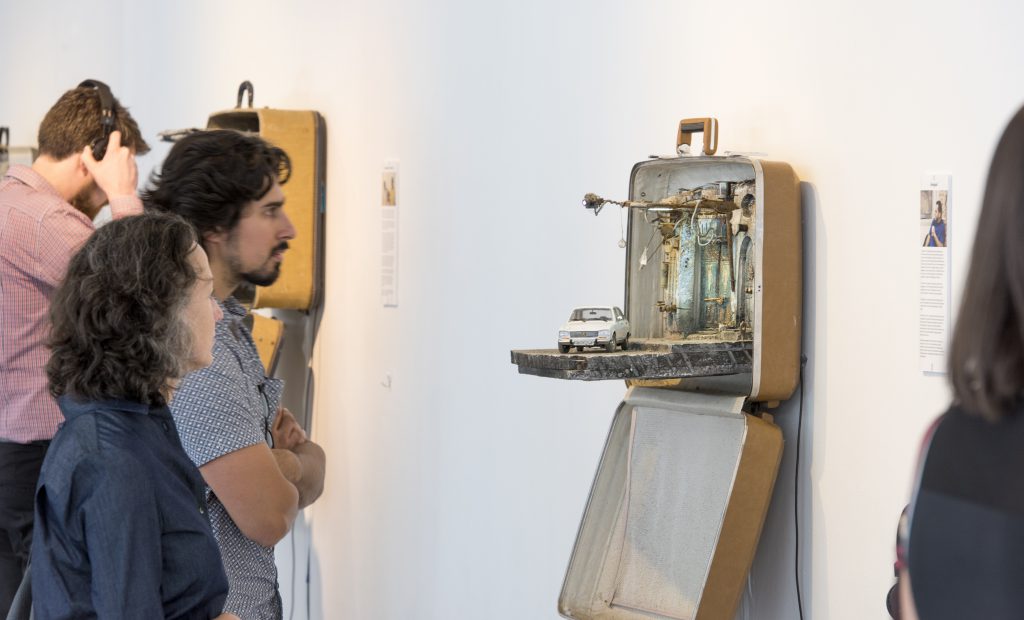 I think my first legitimate miniature-centric experience was in college. Out of homesickness and pure nostalgia, I made my first architectural façade of my homeland, Damascus, one of the oldest continually inhabited cities in the world. I couldn’t go back to Damascus for 8 years and was stuck here, in the United States. The ‘travel ban,’ as we know it today, did in fact exist back then. Sure, it wasn’t called that, but we couldn’t go back to our home. Before the war, the country was in beautiful shape and my family would get together with one another all across the city.
I think my first legitimate miniature-centric experience was in college. Out of homesickness and pure nostalgia, I made my first architectural façade of my homeland, Damascus, one of the oldest continually inhabited cities in the world. I couldn’t go back to Damascus for 8 years and was stuck here, in the United States. The ‘travel ban,’ as we know it today, did in fact exist back then. Sure, it wasn’t called that, but we couldn’t go back to our home. Before the war, the country was in beautiful shape and my family would get together with one another all across the city.
So, while I was making this façade, I attempted to mimic 1,000-year-old walls. I kept painting them… over and over again. I wanted to show bricks crumbling and all the other architecture elements crumbling and aging with time. Even then, from day one as a miniature maker, whatever I did had to be realistic… otherwise it might look too kitsch.
Extremely homesick at the time, I worked for 10 hours straight on this Damascus wall. I sat down in my studio and brought along all my scrap materials from model making. Having worked on a lot of architectural models that semester, I had amassed a great deal of scrap materials including balsa wood and bass wood. Then, I decided to walk along the architectural studios and pick up all the scraps I found. Kids can be a bit wasteful in their freshman and sophomore years, so I collected everything I could find, which was a lot.
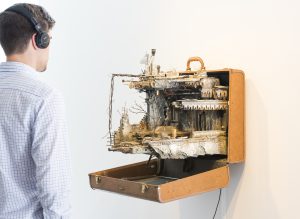 When I was done, that architectural façade belonged to old Damascus. It was almost 15 years ago now, yet I still recall the lightbulb going off in my brain: if I can’t go home, I can recreate home in miniature. And that’s where the love started.
When I was done, that architectural façade belonged to old Damascus. It was almost 15 years ago now, yet I still recall the lightbulb going off in my brain: if I can’t go home, I can recreate home in miniature. And that’s where the love started.
Do you still have that first miniature scene you created?
Yes, I still have that “Old Damascus” façade (although I don’t have a good photo of it!) in my studio. I will never let go of that piece.
How did the UNPACKED: Refugee Baggage project come about? How has your experience with Syrian refugees played a role in your work with miniatures?
I am not a refugee. I am, however, Syrian, and came here the old fashioned way: on a student visa, then earned a working visa, then received a Green Card. Being Syrian, and from Damascus, I do lots of work with the Syrian crisis in an attempt to humanize the situation and help people all over the world (especially the U.S.) relate to what’s going on.
I have a few family members that became refugees in Europe. That was a game changer for my artwork in 2014. Only because, at that point, when you see your own family members in a refugee camp in Europe, you gain a completely new perspective on crisis. It hits you at a very different level when you see your own family in that situation. On that trip, I met people from 30 different nationalities in one place. And they were all refugees.
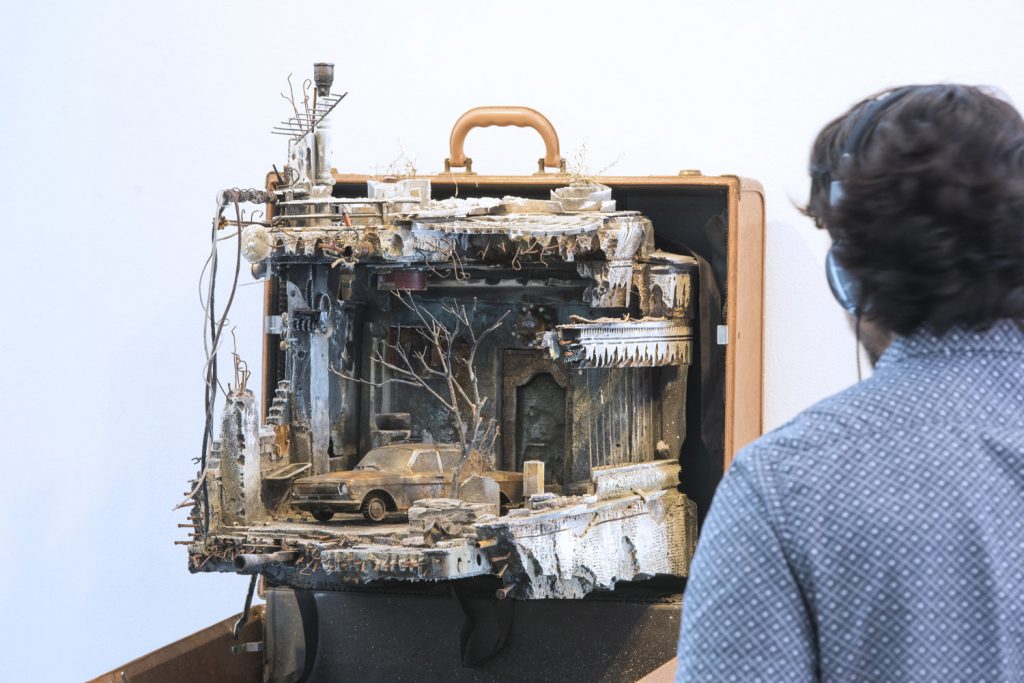 Soon after, I returned to the States very energized to make more work, amidst all the pushback from refugees at that time: calls to stop the program, risk to Homeland Security, and so on. I became very motivated to raise increased awareness that a refugee is not one flavor. It encompasses a huge category, and we can’t judge millions of people by one wide brush stroke. This is a genre of people you were told to fear; but you should make up your own mind and listen to their stories.
Soon after, I returned to the States very energized to make more work, amidst all the pushback from refugees at that time: calls to stop the program, risk to Homeland Security, and so on. I became very motivated to raise increased awareness that a refugee is not one flavor. It encompasses a huge category, and we can’t judge millions of people by one wide brush stroke. This is a genre of people you were told to fear; but you should make up your own mind and listen to their stories.
And so, the UNPACKED: Refugee Baggage project came about. It’s a body of work in miniature, modeled within suitcases. I model the stories (and histories) of refugees into these recently donated suitcases. The suitcases themselves either belonged to the refugees or were donated by people who follow my work and with whom my message resonates. Sometimes people held on to these suitcases for two, three, even four decades. They were holding on to them and decided to give them to me. I appreciate and treasure all of them.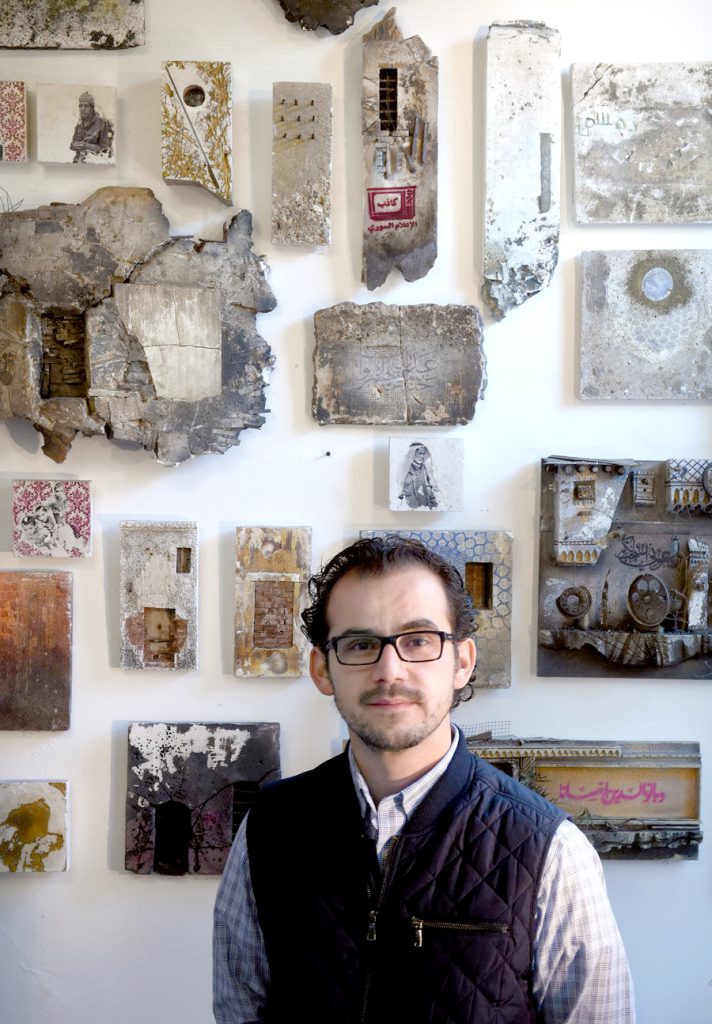
Tell us more about the process and conception behind UNPACKED.
Unless you’re Native American, you’re a second or third generation immigrant in America, meaning your family came here on a boat or plane of some sort. This is a nation built on the backs of immigrants. And here we are, still grappling with xenophobia. Yesterday’s immigrants are helping to tell the story of today’s immigrants. We’re no different. And history does repeat itself. It does not take someone with a PhD to realize this; simply look back a couple clicks in our history. We are united by our differences just as much as we are by our similarities.
This body of work looks at the 10 stories of recent refugee families. Together with my collaborator, Ahmed Badr, we strive to humanize the word “refugee.” Ahmed is a former refugee from Iraq, as well as a writer, social entrepreneur, and poet. He seeks to explore the intersection between creativity, the refugee experience, and youth empowerment. Along the way, his personal mentor has become NPR’s Ari Shapiro.
In 2017, Ahmed and I exhibited our multi-media installation, which re-creates rooms, homes, buildings, and landscapes that have suffered from the ravages of war. Each suitcase is embedded with the stories (and voices) of real people—from Afghanistan, Congo, Iraq, Sudan, and Syria—who have escaped those same rooms and buildings to build a new life here in America.
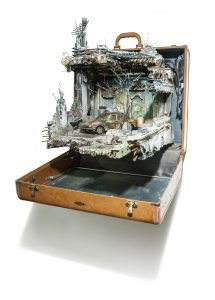 To make this installation come to life, we sat down with each refugee family for hours. For days. We listened carefully as they described their living rooms, bedrooms, and all details from the homes they were forced to leave. I took detailed architectural notes, asking, “what color was the furniture?” and “where did you like most in your house?” and “what was your favorite room,” and so on. I fished for architectural details to better visualize the space when no photos were available (which was in most cases). Then, I’d jump back to the studio and start modeling these scenes in miniature form. At the end of my miniature making process, I embed a concealed media player into each suitcase.
To make this installation come to life, we sat down with each refugee family for hours. For days. We listened carefully as they described their living rooms, bedrooms, and all details from the homes they were forced to leave. I took detailed architectural notes, asking, “what color was the furniture?” and “where did you like most in your house?” and “what was your favorite room,” and so on. I fished for architectural details to better visualize the space when no photos were available (which was in most cases). Then, I’d jump back to the studio and start modeling these scenes in miniature form. At the end of my miniature making process, I embed a concealed media player into each suitcase.
During the installation, there’s a headset on the wall and you can listen to these refugees’ stories through short audio clips. There’s also a placard with more information about the family so viewers can read on and learn a little more. Some of these families went through tough hardships, but that’s not whole story. It’s just part of the story. We flip the coin and ask, “what are you doing today, now that you’re living in America?” They’re architects, engineers, doctors, teachers, pizza delivery men; each played a fundamental role in their own refugee communities. Yes, they’ve all been through hardship. But, life goes on. These refugees have invested in building a future. They give back to their host families and communities. And now they’re vibrant members of their local towns and cities.
What UNPACKED story resonates most with you?
One that comes to mind immediately is a suitcase of Fereshteh, an Afghani girl who wears a headscarf and is thus judged two million ways in this world, sadly. I knew her for about five years here in New Haven and fostered such a great relationship with her family, spending hours at their house and them at mine. For five years I knew them, but I didn’t know a massively important part of their story until we interviewed them for this project.
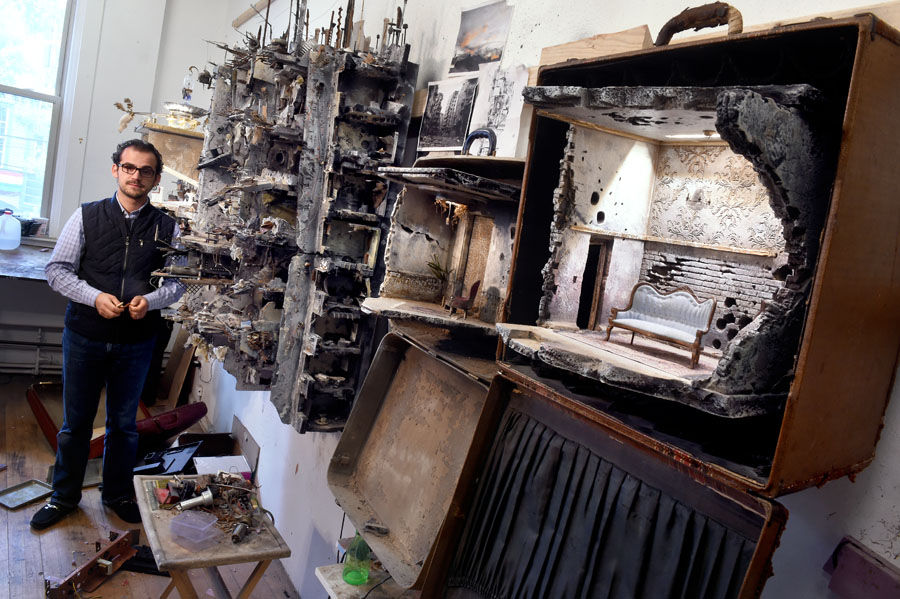 Originally from Afghanistan, they lived in Iran where Afghani refugees are not allowed to attend Iranian schools. Right off the cuff, Fereshteh realized that in her own community alone, there were about 300 children not going to school because they were barred from the Irani educational system due to their citizenship status.
Originally from Afghanistan, they lived in Iran where Afghani refugees are not allowed to attend Iranian schools. Right off the cuff, Fereshteh realized that in her own community alone, there were about 300 children not going to school because they were barred from the Irani educational system due to their citizenship status.
So at the age of 22, she established a secret (underground, and illegal) elementary school at night to teach these children the basics of Arabic, English, math, and so on. It was just her on her own doing this, with help from friends and volunteers. When I heard this, I said “why did you never tell me this before?” And she just shrugged and said, “I don’t think it’s a big deal.”
Do you know the narrative that’s been drawn in the media about Afghani—especially Muslim—women wearing headscarves? There’s a story being painted in today’s world that’s so vastly different from Fereshteh’s. She came to the U.S. as a refugee (finally arriving on September 27, 2011) after the UN realized her humanitarian work with students in Iran was starting to get her in danger. She then pursued a degree in nursing school and is now a Professor of Farsi at the University of New Haven. She’s also an active translator for refugees.
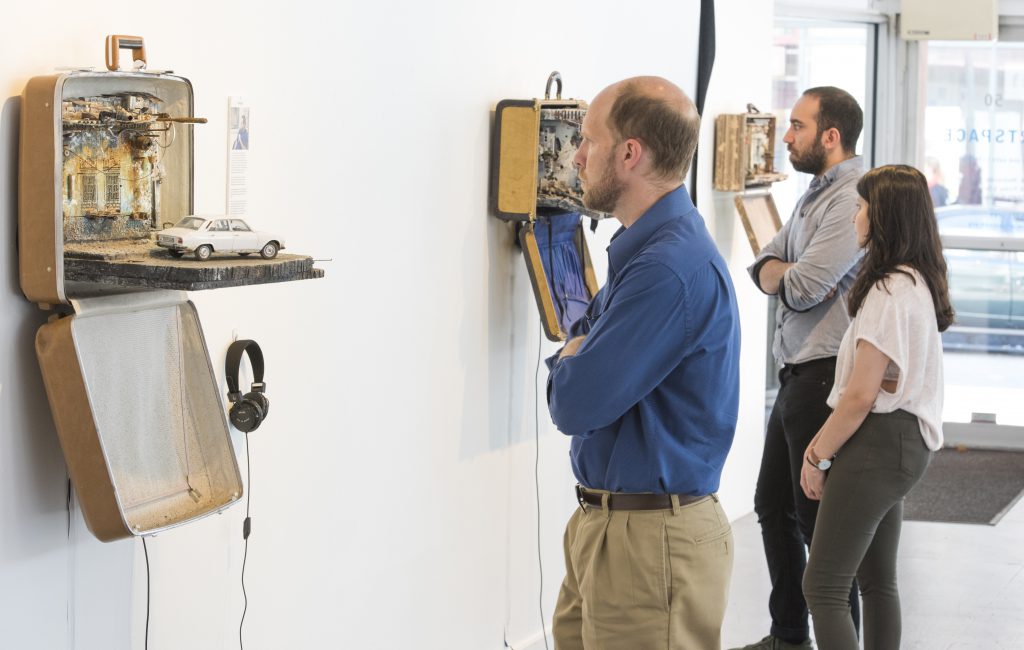 Fereshteh and her husband have been here since 2011, at which time they both hit the ground running. From minimum wage jobs, to becoming adamant about getting an education, to Fereshteh finally getting into nursing school… she’s a fighter and a go-getter with a beautiful soul. It really shook me hard that I had known her for five years and didn’t know this part of her story. For her miniature installation, I imagined a basement where the teacher would sit on the floor with all the kids. And guess what: Fereshteh’s UNPACKED suitcase belonged to her mother! There’s no trademark on it, but someone in Kabul likely handmade it.
Fereshteh and her husband have been here since 2011, at which time they both hit the ground running. From minimum wage jobs, to becoming adamant about getting an education, to Fereshteh finally getting into nursing school… she’s a fighter and a go-getter with a beautiful soul. It really shook me hard that I had known her for five years and didn’t know this part of her story. For her miniature installation, I imagined a basement where the teacher would sit on the floor with all the kids. And guess what: Fereshteh’s UNPACKED suitcase belonged to her mother! There’s no trademark on it, but someone in Kabul likely handmade it.
What have you been up to lately?
I’m currently exhibiting “Unsettled Nostalgia” in Loomis Chaffee‘s Sue and Eugene Mercy Jr. Gallery. The show runs through Wednesday, May 30 and features both sculpture and larger mixed-media installations. There will also be an artistic collaboration created with members of the Loomis community this year.
What’s to come from Mohamad Hafez and the UNPACKED: Refugee Baggage project?
Ahmed and I plan to make many more suitcases to tell more and more stories of even more refugees. From all over the world: Iraq, Syria, Sudan, Iran, Afghanistan, Congo, and beyond.
Some of the UNPACKED suitcases are currently on display at the World Bank in Washington D.C. through July 15. After that time, I will replace these suitcases with some of my other artwork.
We’re blessed to be trusted with all of these stories. And I’ve been blessed with skills of modeling in miniature. Our goal is to touch more people through this project. Looking at art is good in itself, of course, but we want to have a meaningful impact on society. We’ve had people come to us who really want to help and that collaboration has been wonderful. We’ve put students into full scholarships to Ivy League and prep schools and have given funds to small business owners to jumpstart their lives again. I look forward to working with more community partners like universities and prep schools in the New England area.
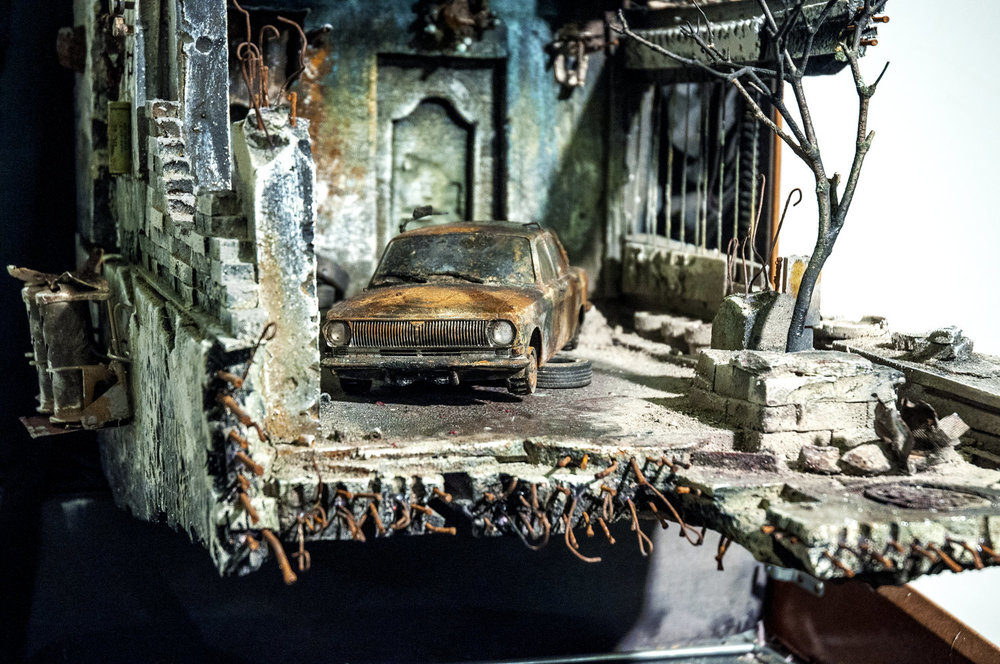 As for me, I am looking for more opportunities to collaborate with community members to take UNPACKED on the road… to every single U.S. state. That’s right, my goal right now is to make 50 suitcases, one for each state. From there, a road trip would make sense, and it could take anywhere from up to 2 years.
As for me, I am looking for more opportunities to collaborate with community members to take UNPACKED on the road… to every single U.S. state. That’s right, my goal right now is to make 50 suitcases, one for each state. From there, a road trip would make sense, and it could take anywhere from up to 2 years.
I look forward to working with a wider audience, nationwide. After all, you don’t just walk into someone’s house and say “tell me your story.“ Rather, it’s important to invest time and grow relationships with these families. Some of what they’ve been through is unimaginable: a missing child, deceased family members, hardship after hardship. We work closely with community members, side-by-side with refugee families settled in the U.S., so that when Ahmed and I come to their city or town, some sort of relationship can be built. We interview them and strive to tell their story through our installations. We also seek to help refugees gain the spotlight for their great skills.
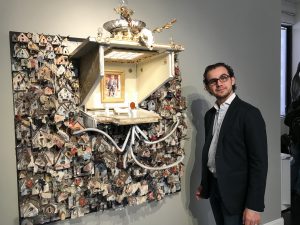 We’re blessed through artwork and miniatures to help families; and to have a tangible impact on improving someone’s life. Ultimately, if we can directly help them stand on their feet again, it would make the world of difference to both of us.
We’re blessed through artwork and miniatures to help families; and to have a tangible impact on improving someone’s life. Ultimately, if we can directly help them stand on their feet again, it would make the world of difference to both of us.
What’s something (most) people don’t know about you?
I’ve never shared this with people before. My work is very three-dimensional. And it’s highly detailed. I’m really interested in empowering people that are disadvantaged or perceived as though they are disadvantaged, or those that have a disability of some sort. People are quick to judge and label people. Particularly those thought to have a disability.
As for my highly detailed work… it takes a lot of skill and a lot of focus. It takes two eyes. What the world doesn’t know about me is that I see through one eye only. My other eye is very weak. So, in a way, I am one of those people with a disability though perhaps I don’t wear it on my sleeve, like those with an evident disability or disadvantage.
So now, I am (and have been) personally committed to helping people. Whether you wear a headscarf (which is, in some ways, a label), or whether you’re an artist with a disability—both sides are very personal to me. We are very quick to judge and turn to celebrities and people under bright lights. Very rarely do we investigate people’s story and what makes people who they are. That’s what drives me. I couldn’t care less about the bright lights. I care about humans and their stories.
A Syrian artist and architect, Damascus-born Mohamad Hafez’s art reflects the political turmoil in the Middle East through the compilation of found objects, paint, and scrap metal. With four highly acclaimed exhibits under his belt, Hafez creates surrealistic Middle Eastern streetscapes that are architectural in their appearance yet politically charged in their content. His UNPACKED collaborator, Ahmed Badr is a writer, social entrepreneur, poet, and former refugee from Iraq who currently attends Wesleyan University as a Fellow at the Allbritton Center for the Study of Public Life.
To learn more about UNPACKED: Refugee Baggage, visit their website or follow along for updates on Facebook, Instagram, and Twitter. For more information on Mohamad Hafez’s art and architecture, check out his website, Facebook, Instagram, and Twitter.
Image credits: Rodney Nelson and courtesy of the artist
